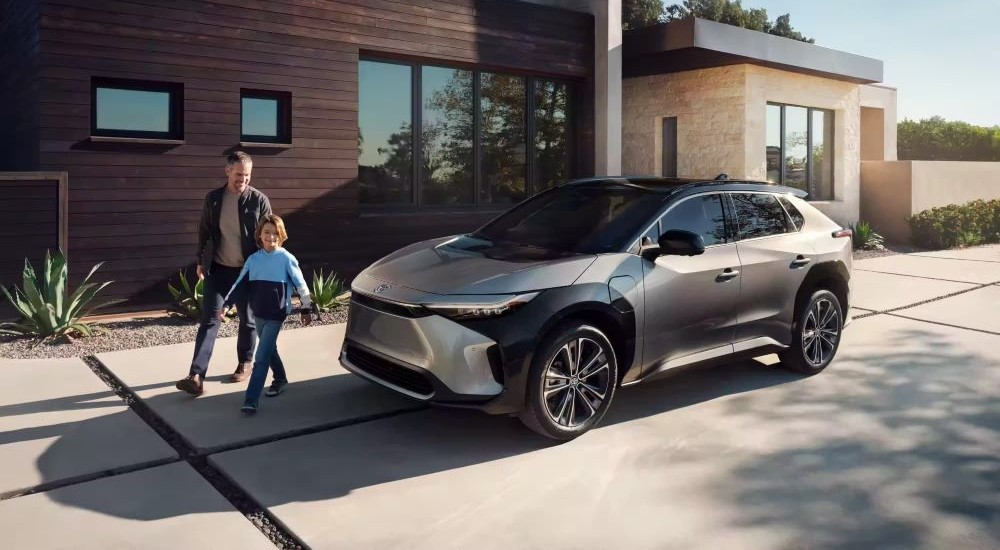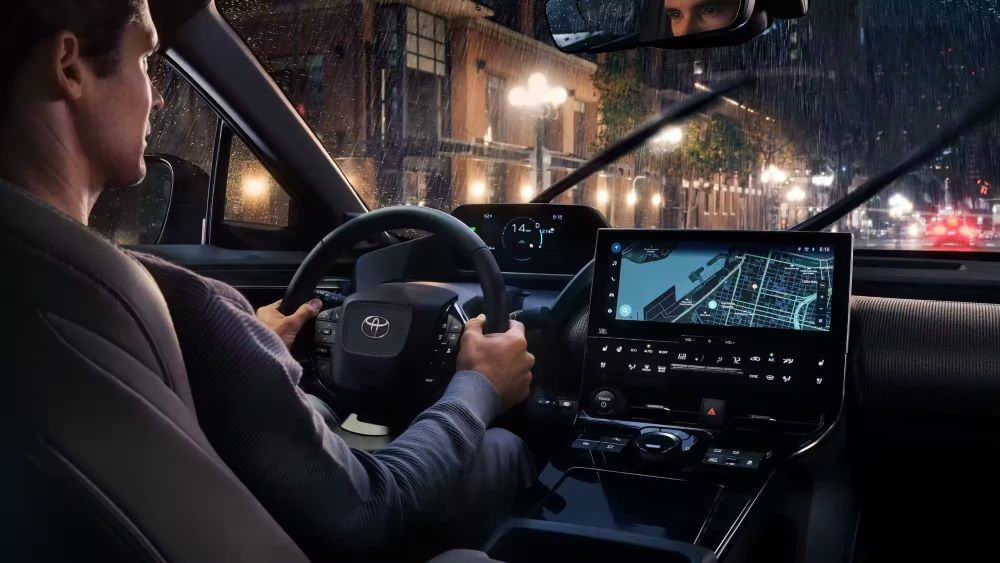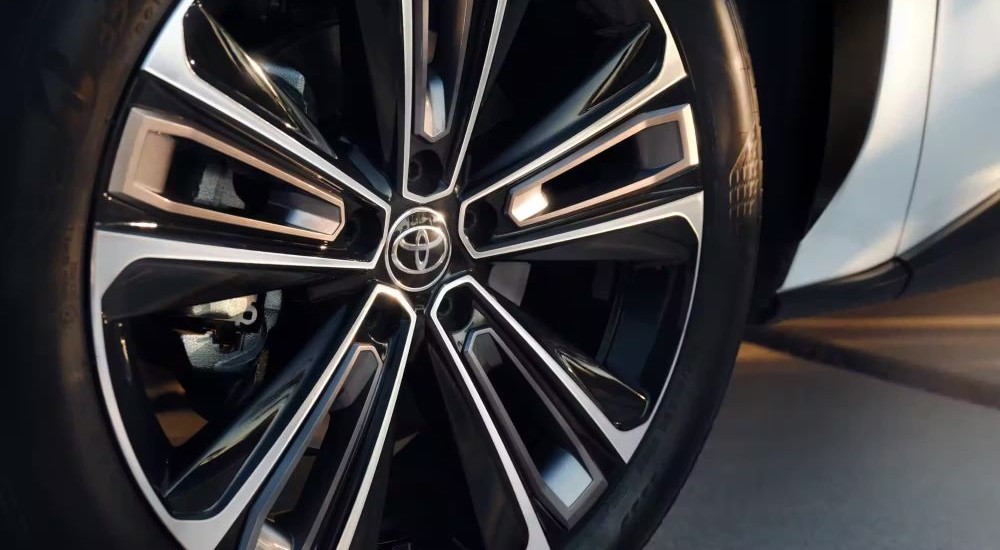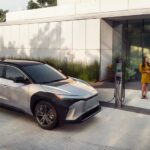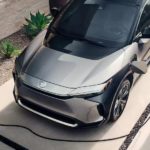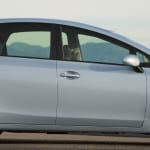The brand that kicked off the modern hybrid craze is back, aiming to do for battery electric vehicles (BEVs) what the Prius did for the hybrid segment back at the turn of the millennium. This year marks the debut of an entirely new model, the 2023 Toyota bZ4X, a battery electric compact crossover that marks the first entry in Toyota’s new Beyond Zero (bZ) line.
Built on the e-TNGA battery-electric platform and co-developed with fellow Japanese brand Subaru, the bZ series is just one part of Toyota’s campaign to introduce fifteen battery-electric models over the next two years. It’s an ambitious plan, to be sure, but if they can pull it off, it could go a long way in cementing Toyota’s status as a force to be reckoned with in the burgeoning world of EVs.
If the model’s name might look like some sort of secret code, well, that’s because it is. The bZ4X ushers in a new naming convention for Toyota’s battery electric vehicles, with all seven models sharing the bZ prefix. The “4” in bZ4X refers to the fact that the model is similar in size to the brand’s best-selling compact crossover in the RAV4, while the “X” designates the bZ4X as a crossover model.
While it might be a mouthful, this name is nothing if not illustrative, and it will eventually allow drivers to easily discern Toyota’s bZ line by name alone. What other secrets is this new Toyota EV hiding? Read on as we explore some of our favorite features of the bZ4X, see how it compares with the rest of the segment, and try to figure out how Toyota has managed to produce such a lavish EV for such a competitive price.
What’s Beyond Zero?
The Beyond Zero concept might sound like a slick—and mathematically impossible—marketing ploy from Toyota, but according to the automaker, it’s all about creating a greener, cleaner world built on environmentally sustainable technologies. “Our goal now is not only to reach zero emissions but to go beyond,” reads a statement from Toyota. “To create vehicles that have a positive impact.”
On the automotive front, that means producing a wide range of electrified vehicles that will encourage buy-in from all corners of the driving public. But why is that so important? BEVs like the bZ4X might be a great solution for city-dwellers or those who live in an area with a robust charging network but can be a non-starter for more rural drivers.
That’s where hybrids and plug-in hybrids come in. More versatile than pure BEVs, these hybrid options provide an important alternative for those who want to embrace the future of transportation without having to constantly be on the hunt for a charging station. As the technology evolves, hydrogen-powered vehicles will likely be another important part of the equation, with Toyota envisioning an eventual transition to a fully hydrogen-based society where personal and public transport—and even entire cities—are powered by one of the world’s most abundant natural resources.
Speaking of public transportation, Toyota is leveraging its partnership with the 2024 Paris Olympic and Paralympic Games to showcase the EV segment’s future. From a human support robot designed to assist patrons who face movement challenges to the brand’s KINTO carshare program and a fully-electric vehicle specifically crafted for wheelchair users dubbed i-Ride, Toyota has its vision set firmly on the future with the Beyond Zero campaign.
The Beyond Zero ethos stretches far past the Toyota lineup itself, encompassing everything from social initiatives and public transportation to large-scale hydrogen power and a full-on reexamination of the way automakers like Toyota participate in society with products, projects, and initiatives that uplift individuals, communities, and the planet as a whole. As part of this ambitious effort, the brand has launched the Toyota Environmental Challenge 2050, which aims to reduce the company’s carbon dioxide emissions by 90% by 2050 while also adopting the UN’s Sustainable Development Goals that target more widespread goals like increasing the number of women in the tech industry.
Slick Interior
Thanks to their lack of large, bulky engines, EVs have long had an advantage over their gas-powered cousins regarding interior space. This is especially true with the bZ4X, which is surprisingly spacious despite its compact designation.
As we mentioned above, the “4” in bZ4X comes from the fact that the BEV is similar in size to the driver-favorite Toyota RAV4, but that’s not entirely true. Measuring 185 inches in length with a 112-inch wheelbase, the bZ4X is actually closer to the Land Cruiser, Toyota’s full-size SUV that hasn’t been available on the US market since 2021. Add 26 cu.ft. of cargo room and 96 cu.ft. of passenger volume, and you’ve got a spacious cabin that goes a long way in enhancing this compact crossover’s convenience.
Best of all, this space is employed wisely, with Toyota including a number of clever storage options that make the most of the already-roomy interior. Take the center console, for example: built with an integrated wireless charging pad, the center console is all more useful because it features an open storage area in its base, utilizing some prime real estate that would typically be jammed with mechanical components on a non-EV.
The open-air storage, spacious interior, and standard fixed-glass roof give the bZ4X an open, airy feel with a modern touch that we’d normally associate with a much higher-end vehicle. Not bad, considering this BEV’s modest $43,335 starting price.
Thanks to its ample dimensions, the bZ4X is a particularly good choice for taller, lankier drivers who might have a tough time squeezing into some other compact crossovers. This BEV boasts 38.6 inches of front headroom and 42.1 inches of legroom, making it easy to stretch out in, get comfortable, and enjoy the ride.
The bZ4X can comfortably seat five, and while it does lack the front trunk or “frunk” shared by many EVs, it can easily transform into a more-than-capable cargo hauler with the deployment of a few folding seats. This crossover features some 38.8 cu.ft. of cargo space behind the rear row, expanding to 56.1 cu.ft. with the second-row seats folded down.
Bountiful Tech
Interior and safety technology is one place where the bZ4X truly shines, offering a full suite of luxurious, next-generation features that make this crossover a great value for the price. It all starts with this SUV’s long list of standard safety features, which range from run-of-the-mill (like traction control, vehicle stability control, and a rearview camera) to some of the industry’s best Advanced Driver Assistance Systems (ADAS).
From Lane-Departure Warning with Steering Assist to Automatic High-Beam headlights, Dynamic Radar Cruise Control, Automatic Brake Assist, and Blind Spot Monitoring with Rear Cross-Traffic Alert, Toyota has loaded the bZ4X with all the features you need to feel safe and secure behind the wheel. Electric vehicles are the wave of the future but can present some safety issues due to their nearly silent operation, so features like Pre-Collision Warning with Pedestrian Detection can make all the difference.
These types of ADAS offerings are becoming increasingly commonplace in today’s market, but few can match the pure scope of the bZ4X’s safety suite, especially when you consider the fact that it all comes standard. If you’re looking to up the safety factor even further, available features like Downhill Assist Control and the Surround View Camera make a great addition to the package.
All the luxury features in the world don’t amount to much if you’re not comfortable, which is why the bZ4X’s seating is such a nice surprise. Plush with padding and support, the front seats make long drives a pleasure and pack a novel surprise for those colder months; drivers opting for the Limited trim can include a radiant heating element in the lower dash of the front row designed to keep your toes and feet warm and cozy during winter drives. It’s a marked improvement over the standard air-blown heat of old, providing a fast, satisfying way to warm up when the temperature starts to drop.
The Limited trim also comes with a heated steering wheel, front and rear ambient floor lighting, an auto-dimming rearview mirror, and a power liftgate, with the latter two automation features making the driving experience a pleasantly seamless experience.
If you’re looking for a taste of opulence on the base trim—and trying to minimize some of the headaches that can come with the EV lifestyle—the XLE Weather package is a must-have upgrade that’s both affordable and practical. This package includes a heated, leather-trimmed steering wheel, heated front seats, and a feature that enables remote-services compatibility for climate preconditioning, ensuring your vehicle will always be ready to go when you are. In addition to climate preconditioning, drivers will also get access to charge planning as well as a Toyota payment system for public charging networks.
Of course, the bZ4X comes with a generous infotainment screen, with this BEV’s display measuring 12.3 inches; it is crisp, sharp and can control everything from music to navigation and hands-free calling. An optional onboard Wi-Fi hotspot gives drivers and passengers the ability to stream their favorite music, and all bZ4X models come with three free years of Toyota’s Drive Connect service, which includes built-in navigation and a “Hey, Toyota” voice-command tool.
Performance & Range
While the bZ4X offers some sophisticated interior design and cutting-edge tech features, there’s no discounting performance and—most importantly—range in an EV. Toyota has launched the bZ4X in two distinct forms for 2023: a front-wheel drive version with a single electric motor and an all-wheel drive version that doubles the motor count to two.
In its front-wheel guise, the bZ4X manages to put out around 201 hp—an impressive figure that puts the compact crossover right up there with some of its closest segment competitors from Volkswagen and Kia. The two-motor, all-wheel drive version sees a modest upgrade in power—215 hp to the FWD’s 201 hp—but it also ups the fun factor by a significant margin, allowing drivers to feel the full force of every pony each time they step on the pedal.
The AWD design offers potent acceleration, making the bZ4X fun to drive without taking too much of a toll on the model’s overall range because, after all, what good is being able to speed from zero to sixty in just 6.4 seconds if it means having to constantly top off the battery?
Speaking of range, the bZ4X holds its own with a 63.4-kWh battery pack providing 252 miles of coverage as an FWD model. Opting for the 65.5-kWh AWD version will knock some 20 miles off the total, but it’s still a bargain when you consider this crossover’s relative spaciousness. For those accustomed to thinking in gallons, that equates to around 131 MPGe around the city and 107 MPGe on the highway!
The bZ4X also has a few tricks up its sleeve to improve its range, including a regenerative braking feature that can be adjusted to offer the maximum battery-charging return every time you slow down. If used wisely, this system can add 10% to 15% of the model’s total range when driving around the city.
The bZ4X’s neatest range-improving trick is reserved for some non-US markets where the compact crossover’s roof is built with integrated solar panels that can add as much as 1,100 miles of range over the course of a year. This feature might not be available to North American drivers at the moment, but it could be something to look forward to in the future.
As it is, the bZ4x can top off its battery in just nine hours with the help of the 6.6-kW onboard charger and a Level 2 power supply. That figure drops to as little as one hour when you employ a DC Fast Charger, which is an important consideration for those who see a lot of long-distance EV travel on the horizon. If you do have some road trips in store, you’ll be happy to hear that Toyota’s BEV comes with a year of free charging at all EVgo locations, allowing drivers to hit the open road without having to worry about when and where they’ll juice up.
The Best of What’s Next: the bZ4X
The bZ4X marks the beginning of an exciting new era at Toyota—one where sustainability, accessibility, and innovation all play a key role. Given its long-standing reputation as a risk-taker in the hybrid vehicle space, it’s little surprise to see Toyota so heavily invested in electrifying the industry’s future.
Toyota’s goal of introducing fifteen electric vehicles—including seven Beyond Zero models—by 2025 might sound ambitious, but it’s just the sort of bold move that’s already led to so much success for this automaker. Toyota is off to a great start with the bZ4X, which ticks all the boxes for performance, comfort, tech, and safety features, not to mention its striking design and high-end features like a fixed glass roof, radiant heating element, and climate preconditioning.
It bodes well for the future of the segment, giving drivers a glimpse at a well-rounded EV that sacrifices nothing and somehow still outshines its predecessors and rivals.
